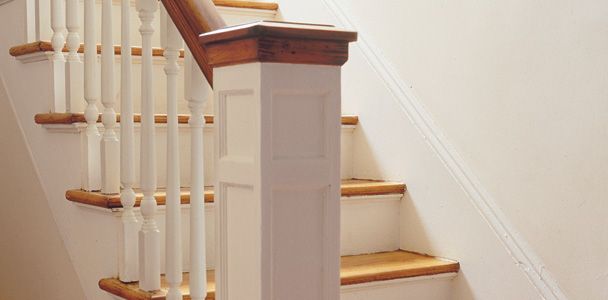Project details
Skill
Cost
Estimated Time
Balusters, also known as spindles, are the vertical posts that support the handrail of a staircase. They play a crucial role in the safety of your stairs, preventing people, especially children, from falling through the gaps between the steps and the handrail.
Over time, balusters can break from accidental damage or wear and tear. Though fixing them may seem daunting, it’s doable on your own with the right tools, materials, and guidance. Our guide will walk you through the process, from removing the old system to maintaining your newly installed spindles.
*Costs in this article sourced from Angi.
Tools and Materials Needed for Baluster Replacement
Before beginning the replacement process, you’ll need to gather all the necessary tools and materials. Here’s what you’ll need.
Essential Tools
- Block plane (optional)
- Drill with 1/16-inch bit
- Hammer
- Miter saw
- Nailset
- Pry bar
- Sandpaper (80-grit)
- Sliding T-bevel
- Tape measure
- Wood glue
 Flat pry bar
Flat pry bar Nippers
Nippers Tape measure
Tape measure Sliding T-bevel
Sliding T-bevel Miter saw
Miter saw Block plane
Block plane Drill/driver
Drill/driver drill bit – 1/16-inch
drill bit – 1/16-inch Hammer
Hammer Nailset
Nailset
Required Materials
- Balusters (custom-made to match existing ones)
- Finishing nails (6d)
- Paint or polyurethane (to match existing finish)
- Wood putty
Assessing Your Staircase and Existing Balusters
Before replacing any balusters, inspect your staircase and the existing spindles. This will help you determine the extent of the work needed and ensure you order the correct replacements.
Measuring and Recording Dimensions
Accurate measurements are crucial for a successful replacement. Measure the following:
- Length of each baluster (they may vary in length)
- Width and depth of the baluster
- Spacing between balusters
Record these measurements carefully, as you’ll need them when ordering custom balusters or cutting new ones to fit.
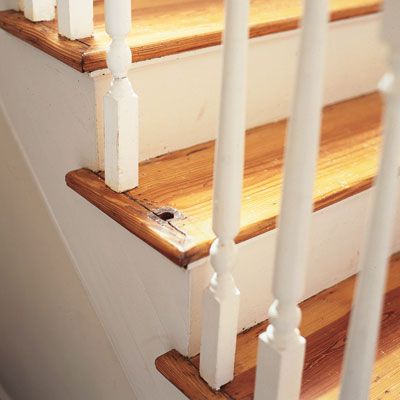
Removing the Old Baluster
Once you’ve assessed your staircase and have the necessary tools and materials, you can begin removing the old baluster. This process requires care to avoid damaging surrounding components.
Detaching the End Cap
Start by removing the end cap from the tread. This cap typically covers the tenon of the baluster where it enters the tread. Use a pry bar to gently lift the cap, taking care not to damage the tread surface.
Extracting the Baluster From the Tread and Handrail
With the end cap removed, you can now extract the baluster. If it has a tenon, gently pull it sideways out of the mortise in the tread. For the top end, tap it with a hammer towards the top of the stair to free it from the handrail. Use nippers to remove any remaining nails from the handrail and tread. Finally, sand the areas around the mortise and under the handrail with 80-grit sandpaper to ensure a smooth surface for the new baluster.
Preparing for the New Baluster Installation
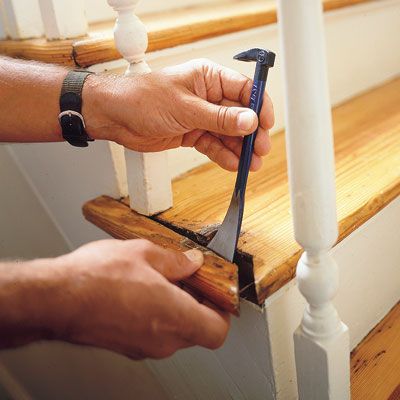
Proper preparation is key to a successful baluster replacement and includes sourcing the right balusters and preparing them for installation.
Sourcing Matching Balusters
Finding balusters that match your existing ones can be challenging. Home centers may not carry exact matches, especially for older or custom staircases. Specialized companies that make stair parts can often create identical balusters using a lathe. To ensure a perfect match, provide them with an intact sample baluster if possible.
Finishing New Balusters Before Installation
It’s much easier to finish your new balusters before installation. Whether you’re applying a coat of paint or varnish, finish the surface of your baluster before moving on to installation. Doing so prevents drips or missed spots that might occur if you try to finish it after installation.
Opening the Tread
Whether removing an intact baluster or replacing a missing one, first pry the end cap off the tread, as shown in the picture above. If taking out a baluster, pull it sideways out of the mortise in the tread, then free the top end by tapping it with a hammer toward the top of the stair. Use nippers to pull out any nails in the handrail and tread and 80-grit sandpaper to smooth the tread around the mortise and the underside.
Installing the New Baluster
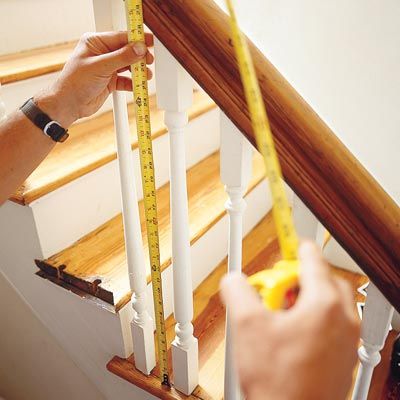
With your new balusters prepared, you’re ready to begin the installation process.
Measuring and Cutting the New Baluster
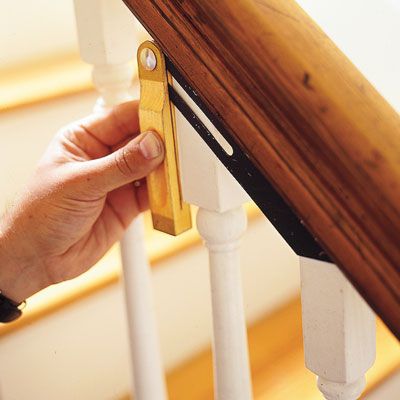
Custom balusters are typically longer than you’ll need them to be, which allows for precise fitting. Follow these steps to cut your baluster to the correct length:
- Measure an existing baluster from the tread to where it meets the handrail on the upstairs side.
- Transfer this measurement to the new baluster, measuring from the bottom edge (not the tenon).
- Use a sliding T-bevel to capture the angle of the top cut by holding it against an existing baluster and the underside of the handrail.
- Mark the cut line on the new baluster using the T-bevel and your length measurement.
- Set your miter saw to the angle determined by the T-bevel and make the cut just next to your marked line.
Fitting and Securing the Baluster
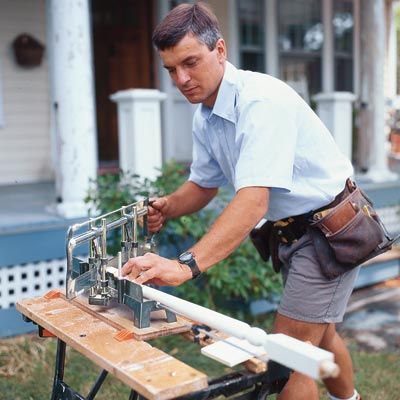
Once cut to size, it’s time to install the new baluster:
- Test-fit the baluster to ensure it sits flat on the tread and has equal spacing at the top compared to neighboring balusters.
- If adjustments are needed, use the miter saw or a block plane to make minor corrections.
- Drill two 1/16-inch pilot holes into the angled end of the baluster, angling them to exit on the upstairs side.
- Apply wood glue to the angled end of the baluster.
- Insert the baluster’s tenon into the tread mortise and align the top with the handrail.
- Drive 6d finishing nails through the pilot holes and into the handrail.
- Use a nail set to recess the nailheads and cover them with wood putty.
- Reattach the end cap to the tread.
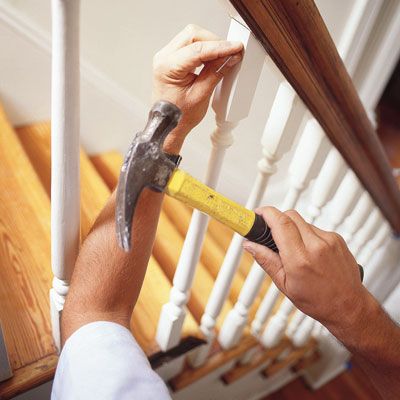
Troubleshooting Common Baluster Replacement Issues
Even with careful preparation, you may encounter some problems during the baluster replacement process. Here are some common issues and how to address them.
Dealing with Mismatched Sizes
If your new baluster doesn’t quite match the size of the original, you have a few options:
- For slight differences, you can use wood filler or putty to smooth out transitions.
- If the new baluster is too thick, carefully sand or plane it down to match.
Addressing Gaps or Loose Fittings
Gaps or loose fittings can compromise both the appearance and safety of your staircase. To fix these issues:
- Use wood glue to secure any loose joints.
- For larger gaps, consider using wood filler or thin wood shims.
- If the baluster is loose in the mortise, wrap the tenon with thin wood veneer or use wood shims to create a tighter fit.
Maintaining Your New Balusters
Regular care can prevent future replacements and keep your staircase looking its best.
Regular Inspection Tips
Perform these checks periodically:
- Check for any loose balusters by gently wiggling them.
- Look for signs of wear, such as chipped paint or varnish.
- Inspect for any cracks or splits in the wood.
Cleaning and Refinishing Advice
To keep your balusters in top condition:
- Dust regularly with a soft cloth or duster.
- Clean with a slightly damp cloth and mild soap solution when needed.
- Refinish balusters every few years or as wear becomes noticeable.
- Touch up paint or varnish as needed to protect the wood.
Our Conclusion
Replacing a baluster is a manageable DIY project that can significantly improve the safety and appearance of your staircase. By following this step-by-step guide, you can replace broken or missing balusters and keep your stairs functional and attractive.
If you’re unsure about your ability to complete the task or if you have a large number of balusters to replace, we recommend consulting a professional. Hiring a professional carpenter can get the job done faster and more efficiently, and they can replace multiple balusters at once, making a potentially daunting task a breeze.
